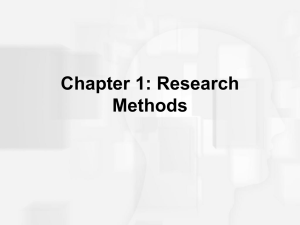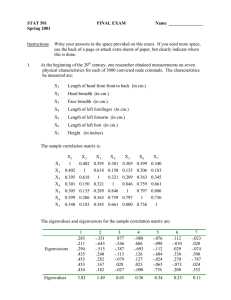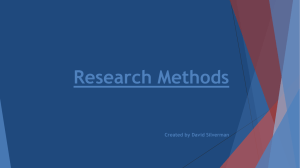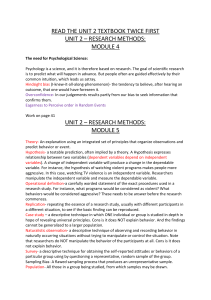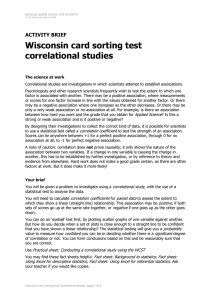Research Methods
advertisement
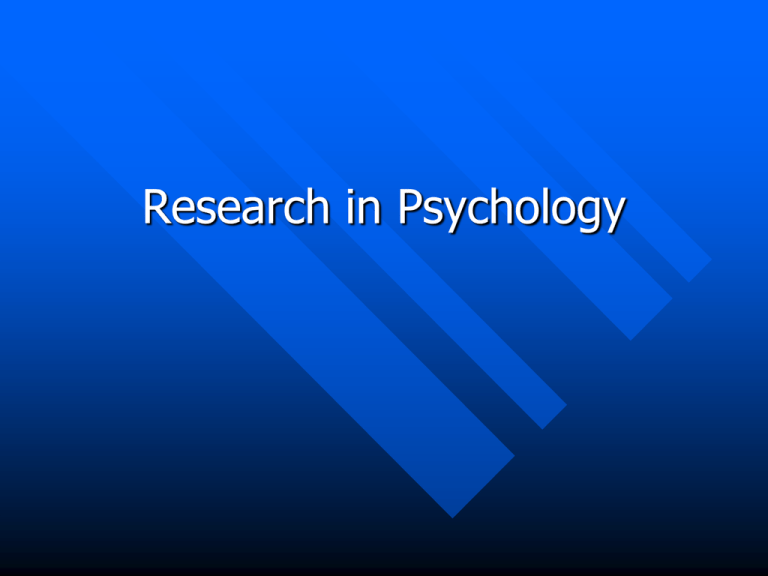
Research in Psychology Agenda 1. Bell Ringer: The Molly Case? (10) 2. Lecture: Research Methods (20) 3. Handout 1-11 and Discussion. (15) 4. M&M Activity, Sampling BB#2 (20) 5. Finish Case Study from yesterday Objective By the end of this lesson you will be able to identify the research methods of Psychology. You will be able to define research terms. Why do we need research? Intuition and Critical Thinking Human Intuition is highly limited. Critically thinking rarely comes easily to us! – Critical Thinking: thinking that does not blindly accept arguments and conclusions »examines assumptions »discerns hidden values »evaluates evidence »An awareness to our own vulnerability Hindsight bias – “I knew it all along” phenomenon where after learning an outcome, one believes s/he could have predicted that very outcome Overconfidence – we think we know more than we actually know This is why we need psychological science. Natural Observation - Systematic study of behavior in a natural setting Description: – Careful observation of humans or animals in real-life situations Strength: – provides descriptions of behavior Weakness: – DOES NOT explain how or why the behavior occurs – only describes it Example: Jane Goodall’s research was naturalistic observation Case Studies Description: detailed information gathered over time on a specific individual Strength: provides descriptive data over a period of time and analyzes new phenomena Weakness: emotional attachment or personal prejudice to subject can effect objectivity Example: Studying patients with gunshot wounds to the head over a period of years to see how injuries changed their behavior. Survey Description: a technique for gathering the selfreported attitudes, opinions, or behaviors of people Strengths: 1. easy administration, scoring, and statistical analysis. Weaknesses: 1. people lie or are opinionated 2. groups should be representative or data is skewed 3. wording of question can sway answers Example: – Survey students about their opinions on homework Sampling when doing studies: Representative samples are necessary because you can’t survey everyone in a given population. Thus you create a random sample that fairly represents a population. (Every person in a group has an equal chance to participate) Ex. You want to survey the school about attitudes on HW. By using a students list where everyone is numbered, you pick as many as possible to participate. The bigger the sample the better – as long as it is representative. M&M Activity No, you may not eat your candy. This is an experiment. All the packages together make up the population from which we are getting the _________ ___________________, representative sample which is each individual package. Each student who selected a pack of M&M’s have selected a random sample _______________. Separate the colors on the desk. You should have according the the Mars company, 30% brown 20% red 20% yellow 10% green 10% orange with a total of 24 M&M’s in a pack. Correlational Method Description: Used to look at relationships between two variables. Strengths: The stronger the correlation the more successfully one variable can be predicted from the other Weaknesses: Does not est. cause and effect. Often a 3rd (an intervening variable) involved Example There is a positive correlation showing that people who go to college will have higher incomes. an increase in one variable tends to be associated with an increase in the other Example 2 If an increase in one variable tends to be associated with a decrease in the other then this is known as a negative correlation There is a negative correlation showing that the more education a person has the LESS likely the are to be racist Correlation and Causation Scatterplot A graph comprised of points that are generated by values of two variables. The slope of the points depict the direction, while the amount of scatter depicts the strength of the relationship. Correlational coefficient: a statistical measure of the degree of relatedness or association between two sets of data that ranges from -1 to 1. Perfect positive correlation Perfect negative correlation No relationship What is the relationship between height and temperament shown in the scatterplot below? It shows a moderate positive correlation. +0.63 Experimental Method Description: researcher manipulates a variable under controlled conditions and observes a response Strengths: Can establish cause and effect relationships. Experiments should be able to be replicated in order to be found valid and reliable. Weakness: Because it is done under controlled conditions hard to apply to real world situation Other types of studies Longitudinal study – study one person or event over a long period of time Ex-post facto study – study something after it happened naturally – look at effect – seek cause Statistics Measures of central tendency – typical scores – Mean – average of scores – Median: middle score in a rank distribution – Mode: most frequent score Statistical procedures analyze and interpret data allowing us to see what the unaided eye misses. Researchers are looking for statistical significance Measures of Variation Range – difference between the highest and lowest scores in a distribution Standard deviation – a computed measure of how much scores vary around the mean (BELL CURVE) A skewed distribution Closure Directions: For each of the following hypotheses, explain which research method would be best and why that method is best. If a cancer patient receives chemotherapy, then they will live longer than a cancer patient who does not. Do people think coffee helps performance at work? How does playing a high school sport effect amount of friends you have? If there are no cars around, then most people do not completely stop at a stop sign If students study more, then they will do better on tests. What percentage of students actually use the bathroom when they ask to go to the bathroom? Students behave differently around teachers. How does laser eye surgery effect vision later in life?







